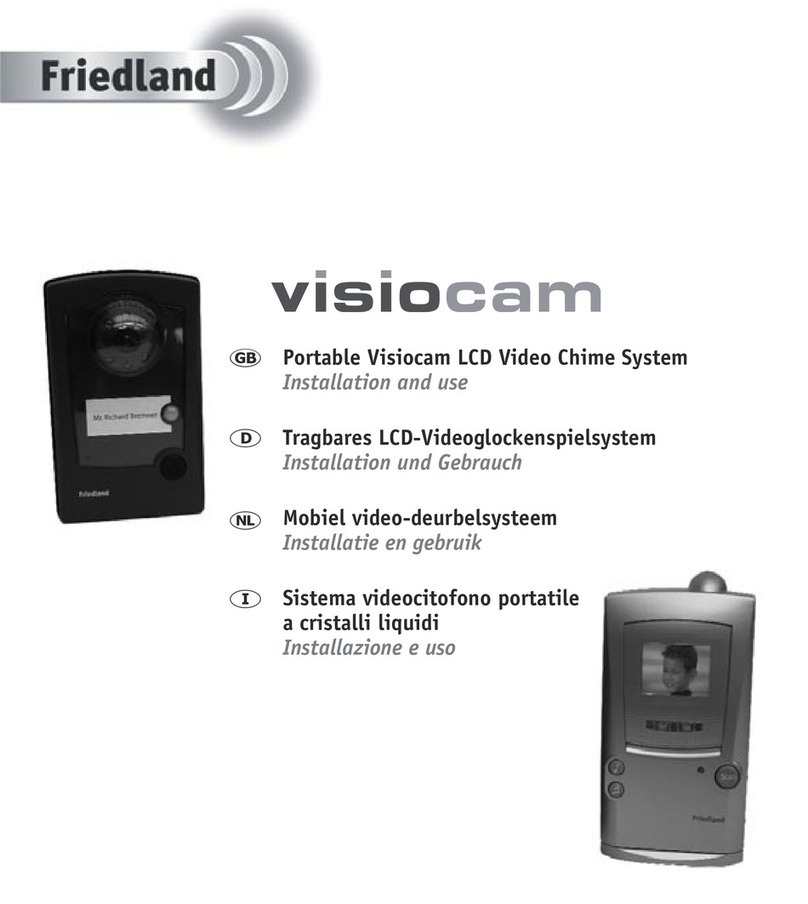There are many ways to expand your entry system:
you can connect your system to a television set or
add more cameras, for example.
TV connection
You can connect the receiver to a TV set via the
accessory SCART cable. The TV set must be equipped
with a SCART input.
When the door camera is activated, the receiver chimes
and the TV switches automatically to display the caller
on the TV.
Note: the automatic picture display is activated using the
TV SCART trigger mode. Some SCART sockets and some TV
sets will not work in this mode and you may need to change
channels manually. Refer to the TV set instructions for
advice.
Adding a door chime
The door camera can trigger one or more Friedland
Evo or Décor chimes in addition to the video receiver.
Additional chimes may be useful in large or noisy
premises.
Note: if you are using an existing chime, you will need to
clear it before it can be programmed to respond to the video
camera. To do this, press and hold in the two chime selection
buttons ‘A and B’ on the chime for around six seconds until
it starts playing its available tunes. The chime is now cleared.
To program the chime, make sure it is located within 8m
(25ft) of the door camera and press and hold the camera
call button until the chime sounds. The chime in now
programmed and ready for use.
Use the tune button on the chime to change the
tune if required. Refer to the chime instructions for
more detailed information. Note that a chime can be
programmed with a total of two door cameras or pushes.
Once programmed, the additional chime will respond to
the door camera call button, but not the tamper switch.
Note: If the wireless door push supplied with a chime is
not required, it can be used as an additional door push to
activate the video entry receiver – see below.
Adding a door push
The receiver will respond to a Friedland Evo or Décor
door push. To program a door push into the receiver:
1. Press and hold the ‘ ‘ button for approximately ve
seconds until the receiver beeps three times
2. Press the door push button until the receiver
sounds.
Note: The video receiver does not respond to a door push
while the video screen is active.
Expanding your system
Additional door cameras
The receiver will respond to up to four door cameras.
Each camera must be set on a different video channel
(1–4), and be programmed into the receiver. Refer to the
instructions provided with the additional unit, or see ‘To
reprogram or reset the receiver’, in this section.
Adding CCTV units
Compatible Friedland products (available from January
2006) will allow you to continuously view the outside
or inside of your premises. Programming is simple, as
with an additional door camera. Refer to the instructions
supplied with the add-on product for full details.
To reprogram or reset the receiver
A. To add another door camera, CCTV unit or bell
push:
Press and hold the ‘ ‘ button for more than ve
seconds, the unit will beep three times and enter
programming mode for approximately two minutes.
During the two minute programming time, press the call
button or button on the new unit to program it in. The
unit must be within 10–20m of the receiver to ensure
reliable programming.
B. To clear all programmed data, e.g. when replacing a
door camera:
Press and hold both the ‘ ’ and ‘ ‘ buttons in for
ve seconds to clear the programmed data and enter
programming mode. The available chime sounds play.
Follow the programming sequence under Receiver Setup.
G-9




























